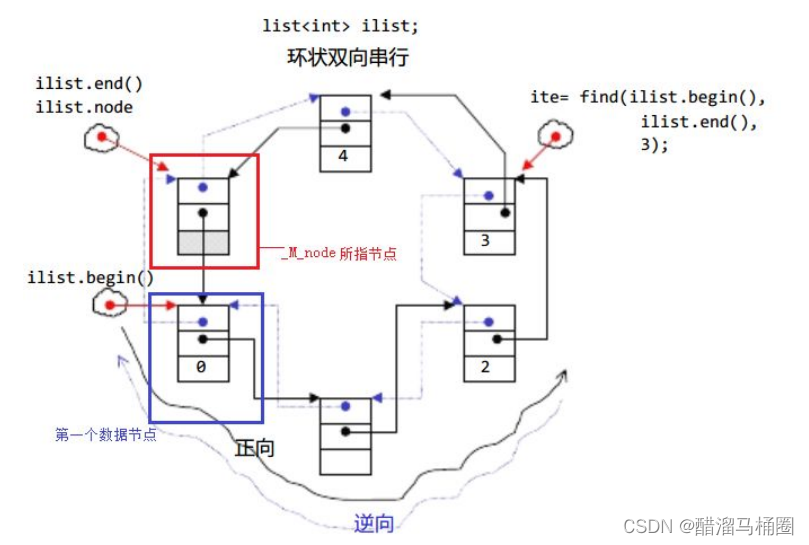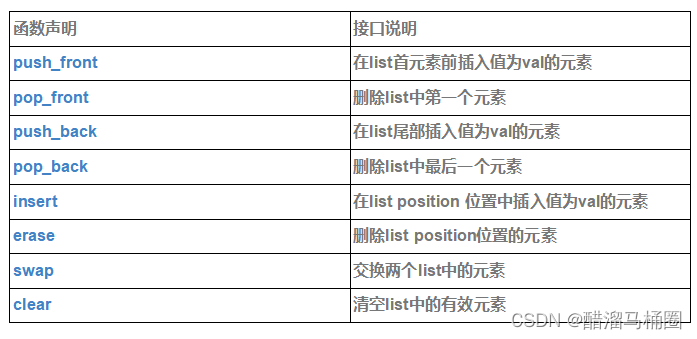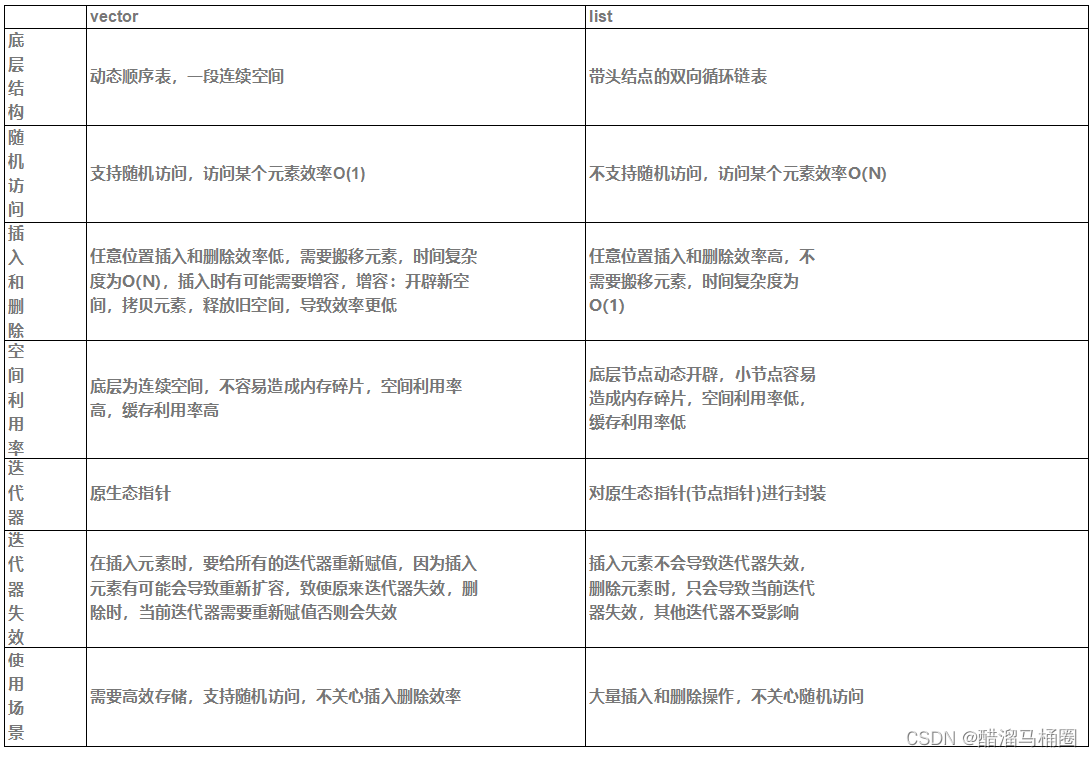目录
1. list的介绍及使用
1.1 list的介绍
list - C++ Reference (cplusplus.com)


1.2 list的使用
list中的接口比较多,此处类似,只需要掌握如何正确的使用,然后再去深入研究背后的原理,已达到可扩展的能力。以下为list中一些常见的重要接口
1.2.1 list的构造

1.2.2 list iterator的使用
此处,大家可暂时将迭代器理解成一个指针,该指针指向list中的某个节点


【注意】
- begin与end为正向迭代器,对迭代器执行++操作,迭代器向后移动
- rbegin(end)与rend(begin)为反向迭代器,对迭代器执行++操作,迭代器向前移动
1.2.3 list capacity

1.2.4 list element access

1.2.5 list modifiers

list<int> lt;
lt.push_back(1);
lt.push_back(2);
lt.push_back(3);
lt.push_back(4);
lt.push_back(4);
lt.push_back(4);
lt.push_back(4);1.2.6 list的迭代器失效
前面说过,此处大家可将迭代器暂时理解成类似于指针,迭代器失效即迭代器所指向的节点的无效,即该节点被删除了。因为list的底层结构为带头结点的双向循环链表,因此在list中进行插入时是不会导致list的迭代器失效的,只有在删除时才会失效,并且失效的只是指向被删除节点的迭代器,其他迭代器不会受到影响
2. list的深度剖析及模拟实现
2.1 模拟实现list
#pragma once
#include <assert.h>
#include <iostream>
using namespace std;
namespace dc
{
template<class T>
struct ListNode
{
ListNode<T>* _next;
ListNode<T>* _prev;
T _data;
ListNode(const T& x=T())
:_next(nullptr)
,_prev(nullptr)
,_data(x)
{}
};
//typedef ListIterator<T, T&, T*> iterator;
//typedef ListIterator<T, const T&, const T*> const_iterator;
template<class T,class Ref,class Ptr>
struct ListIterator
{
typedef ListNode<T> Node;
typedef ListIterator<T, Ref, Ptr> Self;
Node* _node;
ListIterator(Node* node)
:_node(node)
{}
//*it
//T& operator*()
Ref operator*()
{
return _node->_data;
}
//it->
//T* operator->()
Ptr operator->()
{
return &_node->_data;
}
//++it
Self& operator++()
{
_node = _node->_next;
return *this;
}
//it++
Self operator++(int)
{
Self tmp(*this);
_node = _node->_next;
return tmp;
}
//--it
Self& operator--()
{
_node = _node->_prev;
return *this;
}
//it--
Self operator--(int)
{
Self tmp(*this);
_node = _node->_prev;
return tmp;
}
bool operator!=(const Self& it)
{
return _node != it._node;
}
bool operator==(const Self& it)
{
return _node == it._node;
}
};
//template<class T>
//struct ListConstIterator
//{
// typedef ListNode<T> Node;
// typedef ListConstIterator<T> Self;
// Node* _node;
// ListConstIterator(Node* node)
// :_node(node)
// {}
// //*it
// const T& operator*()
// {
// return _node->_data;
// }
// //it->
// const T* operator->()
// {
// return &_node->_data;
// }
// //++it
// Self& operator++()
// {
// _node = _node->_next;
// return *this;
// }
// //it++
// Self operator++(int)
// {
// Self tmp(*this);
// _node = _node->_next;
// return tmp;
// }
// //--it
// Self& operator--()
// {
// _node = _node->_prev;
// return *this;
// }
// //it--
// Self operator--(int)
// {
// Self tmp(*this);
// _node = _node->_prev;
// return tmp;
// }
// bool operator!=(const Self& it)
// {
// return _node != it._node;
// }
// bool operator==(const Self& it)
// {
// return _node == it._node;
// }
//};
template<class T>
class list
{
typedef ListNode<T> Node;
public:
//typedef ListIterator<T> iterator;
//typedef ListConstIterator<T> const_iterator;
typedef ListIterator<T, T&, T*> iterator;
typedef ListIterator<T, const T&, const T*> const_iterator;
iterator begin()
{
//return _head->_next;
return _head->_next;
}
iterator end()
{
return _head;
}
const_iterator begin() const
{
//return _head->_next;
return _head->_next;
}
const_iterator end() const
{
return _head;
}
//初始化头结点
void empty_init()
{
_head = new Node;
_head->_next = _head;
_head->_prev = _head;
_size = 0;
}
list()
{
empty_init();
}
//lt2(lt1)
list(const list<T>& lt)
{
empty_init();
for (auto& e : lt)
{
push_back(e);
}
}
//需要析构,一般就需要自己写深拷贝
//不需要析构,默认浅拷贝就可以
void swap(list<T>& lt)
{
std::swap(_head, lt._head);
std::swap(_size, lt._size);
}
//lt1=lt3
list<T>& operator=(list<T> lt)
{
swap(lt);
return *this;
}
void clear()
{
iterator it = begin();
while (it != end())
{
it = erase(it);
}
}
~list()
{
clear();
delete _head;
_head = nullptr;
}
//void push_back(const T& x)
//{
// Node* newnode = new Node(x);
// Node* tail = _head->_prev;
// tail->_next = newnode;
// newnode->_prev = tail;
// _head->_prev = newnode;
// newnode->_next = _head;
//}
void push_back(const T& x)
{
insert(end(), x);
}
void push_front(const T& x)
{
insert(begin(), x);
}
void pop_back()
{
erase(--end());
}
void pop_front()
{
erase(begin());
}
void insert(iterator pos, const T& val)
{
Node* cur = pos._node;
Node* newnode = new Node(val);
Node* prev = cur->_prev;
prev->_next = newnode;
newnode->_next = cur;
cur->_prev = newnode;
newnode->_prev = prev;
_size++;
}
iterator erase(iterator pos)
{
Node* cur = pos._node;
Node* prev = cur->_prev;
Node* next = cur->_next;
prev->_next = next;
next->_prev = prev;
delete cur;
_size--;
return iterator(next);
}
size_t size() const
{
return _size;
}
bool empty()
{
return _size == 0;
}
private:
Node* _head;
size_t _size;
};
}2.2 list的反向迭代器
通过前面例子知道,反向迭代器的++就是正向迭代器的--,反向迭代器的--就是正向迭代器的++,因此反向迭代器的实现可以借助正向迭代器,即:反向迭代器内部可以包含一个正向迭代器,对正向迭代器的接口进行包装即可
template<class Iterator>
class ReverseListIterator
{
// 注意:此处typename的作用是明确告诉编译器,Ref是Iterator类中的类型,而不是静态成员变量
// 否则编译器编译时就不知道Ref是Iterator中的类型还是静态成员变量
// 因为静态成员变量也是按照 类名::静态成员变量名 的方式访问的
public:
typedef typename Iterator::Ref Ref;
typedef typename Iterator::Ptr Ptr;
typedef ReverseListIterator<Iterator> Self;
public:
//
// 构造
ReverseListIterator(Iterator it) : _it(it) {}
//
// 具有指针类似行为
Ref operator*() {
Iterator temp(_it);
--temp;
return *temp;
}
Ptr operator->() { return &(operator*()); }
//
// 迭代器支持移动
Self& operator++() {
--_it;
return *this;
}
Self operator++(int) {
Self temp(*this);
--_it;
return temp;
}
Self& operator--() {
++_it;
return *this;
}
Self operator--(int)
{
Self temp(*this);
++_it;
return temp;
}
//
// 迭代器支持比较
bool operator!=(const Self& l)const { return _it != l._it; }
bool operator==(const Self& l)const { return _it != l._it; }
Iterator _it;
};3. list与vector的对比
3.1 list与vector的对比
vector与list都是STL中非常重要的序列式容器,由于两个容器的底层结构不同,导致其特性以及应用场景不 同,其主要不同如下

3.2 对比list排序和vector排序
void test2()
{
srand(time(0));
const int N = 1000000;
list<int> lt1;
list<int> lt2;
vector<int> v;
for (int i = 0; i < N; i++)
{
auto e = rand()+i;
lt1.push_back(e);
v.push_back(e);
}
int begin1 = clock();
//排序
sort(v.begin(), v.end());
int end1 = clock();
int begin2 = clock();
lt1.sort();
int end2 = clock();
printf("vector sort:%d\n", end1 - begin1);
printf("list sort:%d\n", end2 - begin2);
}









